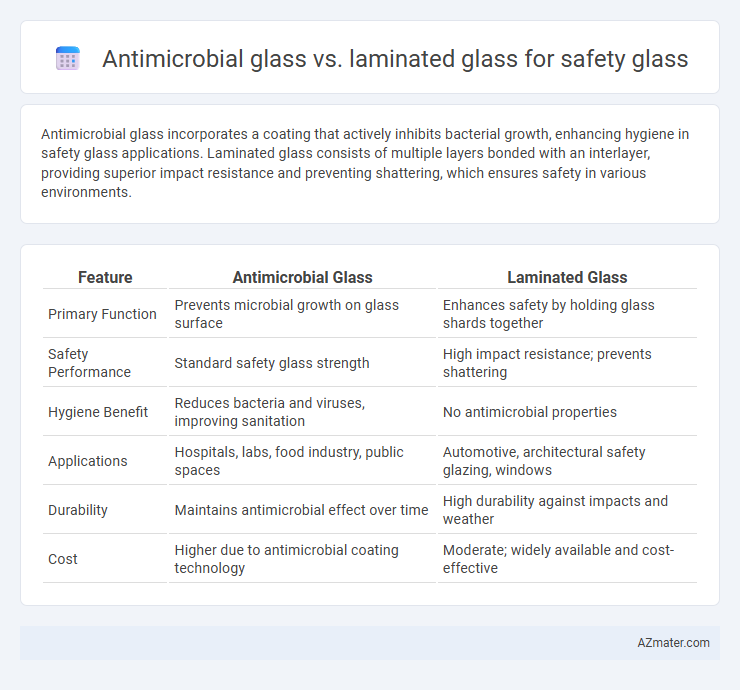Antimicrobial glass incorporates a coating that actively inhibits bacterial growth, enhancing hygiene in safety glass applications. Laminated glass consists of multiple layers bonded with an interlayer, providing superior impact resistance and preventing shattering, which ensures safety in various environments.
Table of Comparison
| Feature | Antimicrobial Glass | Laminated Glass |
|---|---|---|
| Primary Function | Prevents microbial growth on glass surface | Enhances safety by holding glass shards together |
| Safety Performance | Standard safety glass strength | High impact resistance; prevents shattering |
| Hygiene Benefit | Reduces bacteria and viruses, improving sanitation | No antimicrobial properties |
| Applications | Hospitals, labs, food industry, public spaces | Automotive, architectural safety glazing, windows |
| Durability | Maintains antimicrobial effect over time | High durability against impacts and weather |
| Cost | Higher due to antimicrobial coating technology | Moderate; widely available and cost-effective |
Introduction to Safety Glass: Key Types and Functions
Safety glass primarily includes laminated glass and antimicrobial glass, each offering distinct protective features. Laminated glass consists of two or more glass layers bonded with an interlayer, providing impact resistance and preventing shattering upon breakage. Antimicrobial glass incorporates silver ions or copper coatings to inhibit microbial growth on surfaces, enhancing hygiene in environments requiring both safety and cleanliness.
What is Antimicrobial Glass? Composition and Applications
Antimicrobial glass is specially coated or embedded with biocidal agents like silver ions or copper nanoparticles that inhibit the growth of bacteria, viruses, and fungi on its surface. Its composition typically involves a standard glass substrate treated with antimicrobial coatings or laminated with antimicrobial interlayers to maintain transparency while providing hygiene protection. Common applications include healthcare facilities, public transportation, food processing, and architectural elements where reducing microbial contamination enhances safety and sanitation.
Understanding Laminated Glass: Structure and Uses
Laminated glass consists of two or more glass layers bonded by an interlayer, typically polyvinyl butyral (PVB), providing enhanced safety by preventing shattering upon impact. Its ability to absorb energy and maintain structural integrity makes it ideal for applications requiring security and protection, including automotive windshields and architectural glazing. Antimicrobial glass, while primarily designed to inhibit bacterial growth, does not offer the same mechanical safety features as laminated glass in impact resistance and structural performance.
Antimicrobial Properties: How Effective is Antimicrobial Glass?
Antimicrobial glass incorporates metal ions such as silver or copper, which actively inhibit bacterial growth and reduce surface microbes by up to 99.9%, making it highly effective for hygiene-critical environments. Laminated glass, while offering enhanced safety through interlayers that prevent shattering, lacks intrinsic antimicrobial properties and does not reduce microbial contamination. The effectiveness of antimicrobial glass in maintaining cleaner surfaces positions it as a superior choice for applications requiring both safety and infection control.
Safety Performance: Comparing Impact Resistance
Antimicrobial glass incorporates a protective coating that resists microbial growth while maintaining strong safety features, but laminated glass excels in impact resistance due to its multiple bonded layers that hold shattered fragments together. Laminated glass absorbs and disperses impact energy more effectively, minimizing the risk of injury by preventing glass penetration or ejection. This superior impact resistance makes laminated glass the preferred choice for safety-critical applications such as automotive windshields and building facades requiring enhanced protection against breakage.
Durability and Longevity in Different Environments
Antimicrobial glass offers enhanced durability due to its ability to resist microbial growth, which helps maintain surface integrity and cleanliness over time, making it ideal for hospitals and high-touch environments. Laminated glass provides superior impact resistance and retains strength even if the outer layers are damaged, ensuring long-lasting safety in both indoor and outdoor settings. While antimicrobial glass excels in hygiene maintenance, laminated glass delivers unmatched structural durability and longevity across diverse environmental conditions.
Hygiene and Cleanliness: Antimicrobial Glass vs Laminated Glass
Antimicrobial glass incorporates silver ion or copper-based coatings that actively inhibit the growth of bacteria, viruses, and fungi on its surface, enhancing hygiene in high-contact environments. Laminated glass, while offering excellent impact resistance due to its interlayer, does not possess inherent antimicrobial properties and requires regular cleaning to maintain surface cleanliness. In settings prioritizing hygiene and cleanliness, antimicrobial glass provides a proactive solution by reducing microbial contamination, making it superior to laminated glass for preventing the spread of pathogens.
Cost Considerations: Initial Investment and Maintenance
Antimicrobial glass generally incurs higher initial investment costs due to specialized coatings or embedded materials that inhibit microbial growth, making it more expensive than standard laminated glass. Laminated glass offers cost-effective durability with easier maintenance, as its multi-layer design enhances safety and requires minimal upkeep over time. Maintenance for antimicrobial glass includes potential reapplication or replacement of coatings to retain efficacy, increasing lifecycle expenses compared to laminated glass's relatively low maintenance requirements.
Environmental and Health Implications
Antimicrobial glass integrates silver or copper ions that inhibit microbial growth, reducing surface contamination and contributing to healthier environments, especially in high-touch applications. Laminated glass combines layers of glass with an interlayer that enhances impact resistance and safety but does not inherently possess antimicrobial properties, potentially allowing microbial buildup over time. From an environmental perspective, antimicrobial glass production involves higher energy consumption and the use of metal additives, while laminated glass recycling is challenged by its composite structure, impacting sustainability efforts differently.
Choosing the Right Safety Glass: Factors to Consider
Antimicrobial glass offers enhanced hygiene by incorporating silver ion technology that inhibits microbial growth, making it ideal for healthcare and food industry environments. Laminated glass excels in impact resistance and shatterproof safety due to its interlayer that holds glass fragments together, providing superior protection against breakage and intrusion. When choosing the right safety glass, prioritize factors such as required hygiene levels, impact resistance, compliance with safety standards, and specific application environments to ensure optimal performance and safety.

Infographic: Antimicrobial glass vs Laminated glass for Safety glass
 azmater.com
azmater.com